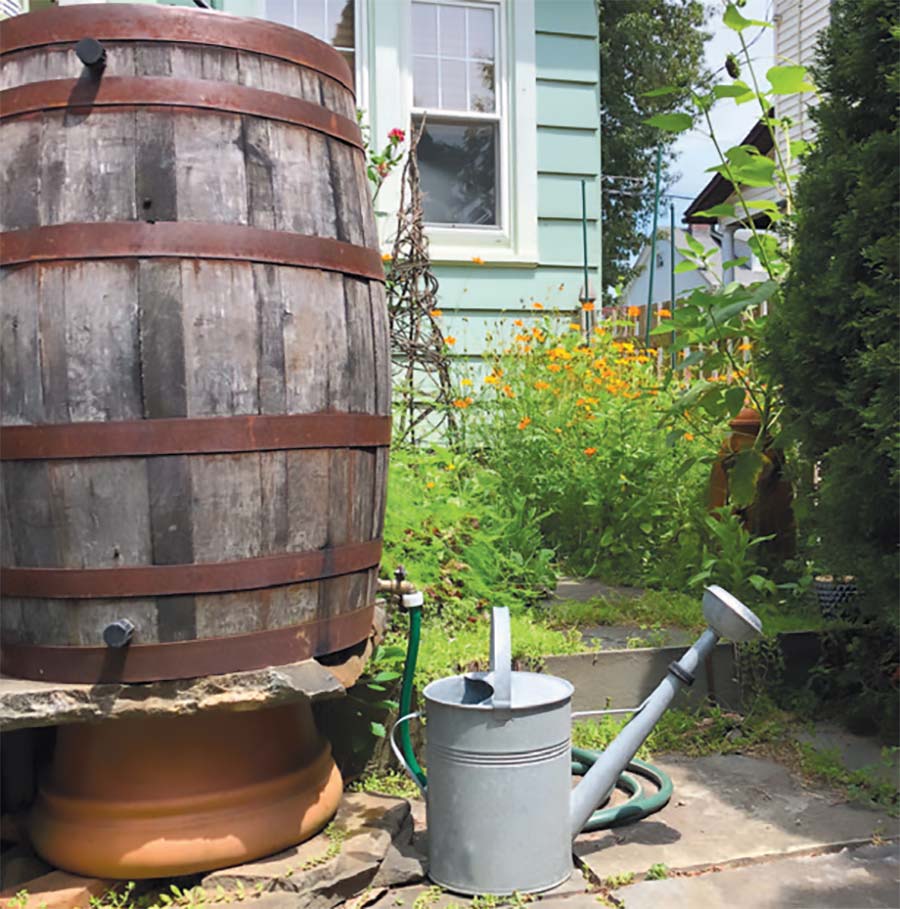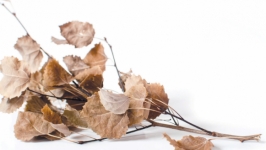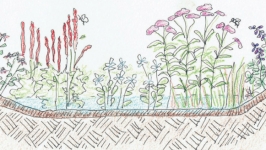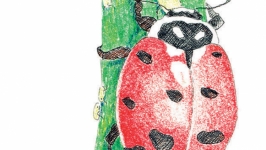8 Steps to a Sustainable Yard
 My yard is my refuge—and yours probably is too, whether it takes up a good portion of the landscape surrounding your home or is just a small border by your back steps. Watching the seasons pass grounds us in time, with the awakening in the spring, bursts of color in summer, glowing golden and red in fall, and subtle structure in winter. Those of us with suburban yards are in a unique position to help the local environment. Our yards and our gardens aren’t just for ourselves. We share our little piece of paradise with the local birds and insects. In fact, beneficial bugs and birds that make their homes in our outdoor landscapes are an indicator of environmental health. But around the globe, we are losing species at an alarming rate because of climate change and habitat loss. A thoughtfully designed landscape can provide the habitat and food these essential creatures need and help to keep us and our planet healthy.
My yard is my refuge—and yours probably is too, whether it takes up a good portion of the landscape surrounding your home or is just a small border by your back steps. Watching the seasons pass grounds us in time, with the awakening in the spring, bursts of color in summer, glowing golden and red in fall, and subtle structure in winter. Those of us with suburban yards are in a unique position to help the local environment. Our yards and our gardens aren’t just for ourselves. We share our little piece of paradise with the local birds and insects. In fact, beneficial bugs and birds that make their homes in our outdoor landscapes are an indicator of environmental health. But around the globe, we are losing species at an alarming rate because of climate change and habitat loss. A thoughtfully designed landscape can provide the habitat and food these essential creatures need and help to keep us and our planet healthy.
Here are some easy ways to make your yard more sustainable and restore some of the balance to the ecosystem that suburban development has destroyed.
1. Ban Chemicals from Your Property
Insects may be annoying, and even damage some plants, but they are also vital to a healthy ecosystem. While you may spray pesticides to attack a specific pest, the poison does not discriminate. It will kill far more beneficial insects than harmful ones, not to mention what it will do to your family and pets. When absolutely necessary, use a homemade organic product that will not harm the environment. Soapy sprays for insects, vinegar sprays for weeds. Google a recipe; there are many.
2. Love Your Lawn, But Have Less of It
Take good care of your lawn and the environment by switching to organic fertilizers. Better yet, just add a thin layer of compost over it in the fall. In the growing season, use a mulch mower and leave grass clippings on the lawn. They supply needed nutrients and help keep weeds at bay. Mow high and frequently, never cutting off more than ⅓ of the grass blade. Mowing high helps prevent weeds and crabgrass and encourages deep roots, which are important on hot summer days. And don’t worry so much about the weeds.
But all that lawn maintenance is a lot of work, so why not get rid of some of your lawn? Lawns use a lot of resources, water and fertilizer. If you don’t use all of your lawn for entertainment or sports, some of it could be put to better use as a vegetable or pollinator garden.
3. Create a Habitat for Wildlife
However big or small your yard, you can probably add more plants. Planting densely with native plants like those you see in wild areas provides birds and insects with food, shelter, and nesting sites. In fact, the denser the planting, the less weeding you’ll have to do because plants block out the light that weed seeds need to germinate.
Plant masses of the same native species instead of one of each plant. And remove any invasives from your garden; Japanese barberry, burning bush and Norway maple are the three worse offenders. These common landscape plants invade spaces where native plants once thrived, but they don’t support local wildlife the way the native plants they overran do.
4. Save the Rain
Water is a resource to use carefully. For each inch of rain collected from a 500-squarefoot roof area, you can collect 300 gallons of water. So install a rain barrel or two and use the water for potted plants or landscape beds. I am partial to wooden whiskey barrels but there are tons to choose from. You can fill up watering cans or run a soaker hose from the rain barrel’s spout into your landscaped beds. I’m adding a second barrel this year because my first one was so successful.
5. Compost Your Food Scraps
Whether you build a composter or buy one, start composting your food waste. It’s great for your soil and conserves landfill space. Chop up your scraps for rapid composting. Match your food scraps one-for-one with dry brown leaves, sawdust, or newspaper. Once the compost is ready, it should smell earthy and sweet. Use it as mulch, soil amendment, or organic fertilizer for your plants. If you are worried about attracting critters, get an enclosed composter. I use a big barrel-style one with two compartments, which gives me one side for compost that’s finishing while I can still put fresh scraps in the other.
6. Think Long Term, Plant a Tree
One of the most ecologically important things we can do in our yards is to plant a shade tree. An act of optimism, yes. It may seem like a grand gesture for a future generation. But while it may not provide you with shade for years to come, you’ll surprise yourself in 15 years when you are sitting in its shade.
No need to plant a huge one. A tree measuring three inches across at four feet up, once planted, will spend the next few years growing roots, and seem not to grow at all up top, but a young sapling planted at the same time may very well catch up to it in just a few years. The cost difference for these is a few hundred dollars, so find a sapling at your local nursery and plant a tree this spring. Oak, maple, or white pine are some of the most valuable to the environment, but any NJ native will do.
Shade trees are beautiful to look at. They can hide undesirable views. They keep us cool, reduce noise pollution, and sequester carbon. Trees produce the oxygen we breathe, and the list of benefits goes on. Studies show we feel better around trees, we are more productive and less stressed. Trees provide habitat for so many plants and animals that are critical to a healthy environment and ultimately our health.
7. Use Less Stuff, Recycle
Yes, of course, your bottles and cardboard. But recycle or “upcycle” things in your yard. Upcycling is the practice of taking a throwaway item and repurposing it for something else. I have a wall in my back yard that was built from pieces of a sidewalk that was removed nearby. I asked the contractor to dump the pieces on my driveway and with the help of my husband, Max, we broke them into useable pieces and built a wall same as if they were large pieces of stone. My rain barrel is an upcycled whiskey barrel. And while my steel pergola is not made of recycled materials, steel is one of the most recycled materials there is. At the end of its useful life it can be recycled into something else. The idea is to keep things out of the landfill.
And pay attention to what you are buying. When you look for your rain barrel and composter this spring, make sure they are made from recycled materials.
8. Learn Weeds
I have been learning to identify weeds this year and still have a long way to go. But it has helped me to know which weeds or wildflowers are native and which are not; which ones to pull and what to leave alone for the insects to enjoy. My favorite phone app for plant identification is PlantNet, and my favorite book is Newcomb’s Wildflower Guide.
What you do in your own yard might seem insignificant in the scheme of things, but if each of us does just a few things to help the environment, together we can make a difference.

SUSTAINABLE RESOURCES
RAIN BARRELS
For an upcycled rain barrel like mine, go to Etsy. These are authentic whiskey barrels. They smell like whiskey when they first get wet, and if you put yours away in winter like I do, when you first take them out the staves (boards) will have shrunk and water pours out. Within a few minutes of getting wet, they swell and hold water beautifully. They come with all you need to connect to your downspout. Search for “whiskey barrel + rain barrel” to narrow in on the best choices. Average price $400.
Local distillers are also a source for whiskey barrels for upcycling. Claremont Distillery (claremontdistillery.com) and Jersey Spirits Distilling Co. (jerseyspirits.com), both in Fairfield, often offer used barrels. At 53 gallons, they’re the perfect size for capturing rainwater. Contact Tim Koether at tim@claremontdistillery.com or kelly@jamesfchyde.com, respectively, for pricing and availability.
Wayfair (wayfair.com) carries rain barrels made from recycled shipping drums, for just over $100, but check first with your local nursery. Most are sure to carry rain barrels in spring. Look for recycled material content for the most sustainable options.
COMPOSTERS
I love my dual-batch compost tumbler from Gardener’s Supply Company (gardeners.com). One bin can be “cooking” while I add fresh material to the other side. If you prefer, create your own DIY bin from recycled pallets or wire fencing, a quick Google search will lead you to a variety of instructions online.
Java’s Compost, based in West Orange, offers a wide range of residential and commercial composting services to homeowners and small businesses throughout Essex, Morris, and Union counties. Java’s has the expertise and equipment to create backyard systems, including tumblers and other essential supplies, that empower customers “to compost in a way that best fits their lifestyle,” says co-founder Michelle Bradley. Want to help the environment, but don’t have time to compost? They’ll also pick up your buckets of food scraps on a weekly basis. javascompost.com
PLANTS
Many garden centers in the Garden State now have NJ native plant sections. To find them, go to jerseygrown.nj.gov. Some of my favorite retailer growers include Toadshade Wildflower Farm in Frenchtown (toadshade.com) and Wild Ridge Plants in Alpha (wildridgeplants.com).
Jersey-Friendly Yards, an initiative developed by the Barnegat Bay Partnership with a grant from the New Jersey Department of Environmental Protection, is another great resource. Along with tips on how to create an earth-friendly yard and an extensive database of native plants, they offer a monthly webinar series, January through June, and an “Ask an Expert” forum. jerseyyards.org







